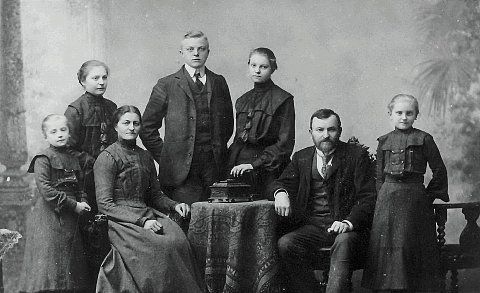-
Standard Combo Package
review on March 20, 2014
by Craig Macpherson

At a Glance
Summary
In conclusion I was impressed with the DNA Ancestry Project and felt their DNA test was good value for money given the number of features you get. I’d add that the PDF guides, video tutorials and FAQ sections are all really helpful when reviewing your results and using the tools.
The online account can be a bit clunky at times but that said, the DNA Ancestry Project manages to balance the basic features a beginner would want with all the tools a genealogy expert would require.
Full Review
After doing a little research I discovered the DNA Ancestry Project which offered genetic ancestry testing.
Participation kits were available for tracing my paternal line, maternal line, or both as a combination package. All prices were in US dollars and I could pay more for advanced versions of the tests which would analyse more markers. I chose the standard ‘Y-DNA 20 Marker + mtDNA HVR-1’ combo test, to trace both my paternal and maternal lineage.
Product Expectations
It wasn’t clear what format the results would be in or if I’d receive anything else as part of the test. However, I hunted around the site and discovered I’d also be given access to the DNA Ancestry Project public genealogy database, and have the opportunity to see if I'm related to historical figures like Marie Antoinette and Thomas Jefferson!
Ordering Experience
The order process was really simple, the kit arrived a week after making the payment and was easy to complete. Unfortunately there was no indication of how long the test would take and I was disappointed to see that return postage to Canada hadn’t been included. After sending off my samples I received confirmation of receipt one week later.
The kit said I’d have to keep checking my online account for the results which was irritating. An email from the DNA Ancestry Project confirming when the results were ready would have saved me the trouble of checking every few weeks.
The Results
In the end the results took more than eight weeks to be uploaded to my online account, the main sections were titled: ‘DNA Haplogroups’, ‘Indigenous DNA’, ‘DNA Reunion’, ‘DNA Archaeology’ and ‘Family Tree’.
Results Section: DNA Haplogroups
In the DNA Haplogroups section I was told my paternal haplogroup was R1b and my maternal haplogroup was H. I was informed that the founder of the R1b lineage lived over 35,000 years ago and that this group is believed to be descended from the ‘Cro-Magnon’ people. In comparison, haplogroup H emerged 20,000 years ago and spread through Europe at the end of the last ice age.
Migration maps were available that showed my paternal ancestors originally travelled from Africa to the Middle East before arriving in the UK, and my maternal ancestors migrated from Africa to Greece before moving up through Eastern Europe to Scandinavia (shown below). ‘Phylogenetic trees’ were also displayed so I could see where my haplogroups fitted in relation to all human lineages.
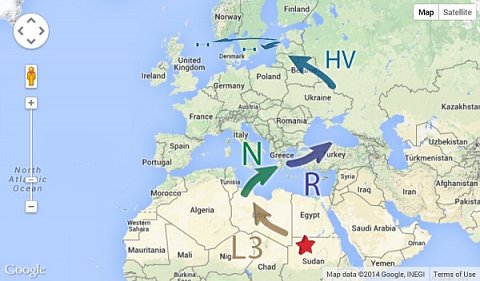
The migration map of mtDNA haplogroup H.
Results Section: Indigenous DNA
The Indigenous DNA section let me compare my paternal and maternal markers against those found in populations from around the world. The comparisons were in the form of tables showing population groups and my corresponding 'Relative Match Index' (RMI). Each population group was linked to the scientific paper that had identified the relevant markers, and I thought this was really thorough. My paternal marker comparison table is shown below.
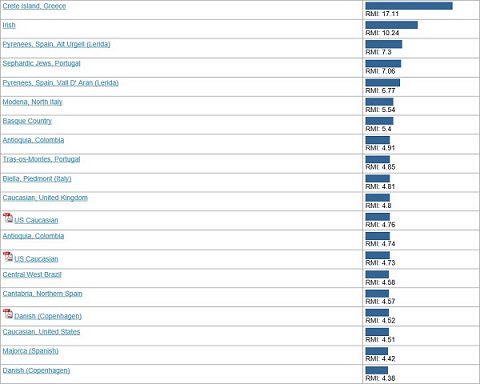
My paternal marker comparison table which draws on a dataset of 416 populations, in 20 journals, using 6 Y-DNA STR markers.
I was surprised to see that my highest rated paternal match was with populations from Crete (25%), whilst my highest rated maternal matches were with Slovenians (8%) and Bulgarians (6%)!
Results Section: DNA Reunion
In the DNA Reunion section my Y-DNA and mtDNA had been matched with others, allowing me to find living relatives in the DNA Ancestry Project database. For Y-DNA I matched with 16 individuals and for mtDNA I matched with 560! I could send messages to my matches and in some cases see the common ancestor we shared. Matches could also be plotted on maps so I could see where they lived or even where they were born. A section of my mtDNA match table is shown below.

The first four of my 560 mtDNA HVR-1 matches at 0 mutational difference.
Results Section: DNA Archaeology
The DNA Archaeology section allowed me to read biographies of eight famous historical figures and discover how I was related to them. When matching my mtDNA with Marie Antoinette I could see we weren’t closely related on our maternal line. However, when matching my Y-DNA with Niall Noigiallach – an Irish King who reigned from 368 to 395 AD – I could see I’d matched 10 of 11 markers meaning it was likely we shared a recent paternal ancestor, and possibly that I was one of his descendants! A table showing the markers I matched with Niall Noigiallach is shown below.
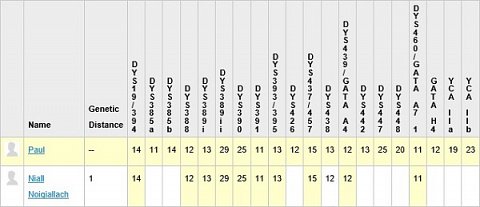
A table showing that I matched 10 of 11 Y-DNA STR markers with the Irish King, Niall Noigiallach.
Results Section: Family Tree
The Family Tree section allowed me to build a tree from scratch or upload a GEDCOM file. For any relatives I added the system calculated the genetic connections between us, and showed the markers in my DNA which I'd inherited along each branch. Unfortunately the tool seemed to be limited to the number of family members I could convince to sign up, and there didn’t seem to be an easy way to pull in my matches from the DNA Ancestry Project database. The pre-prepared family tree for me to build upon is shown below.
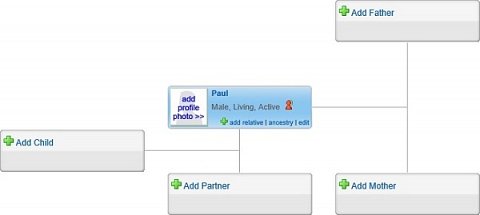
The pre-prepared family tree for me to build upon using the DNA Ancestry Project family tree tool.
Summary
In conclusion I was impressed with the DNA Ancestry Project and felt their DNA test was good value for money given the number of features you get. I’d add that the PDF guides, video tutorials and FAQ sections are all really helpful when reviewing your results and using the tools.
The online account can be a bit clunky at times but that said, the DNA Ancestry Project manages to balance the basic features a beginner would want with all the tools a genealogy expert would require.
See a description of this DNA test from DNA Ancestry Project >

